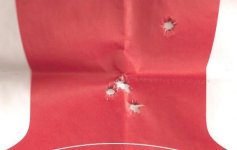M
Marine sniper
Guest
I hang out on this forum pretty often trying to pick up tips from the most accurate shooters to help improve my own long range shooting.
I have a 300 Wby that is capable of very good accuracy, but when I shoot groups at 100 yards I more often than not have a shot kicked out of the group. The same things happens when I shoot 300.
The rifle is a custom rig I built several years ago but have only been shooting it a lot the last couple of years.
Mk5 action.
Turn neck 300 Wby (.332) neck. I have been shooting with .001-.0015 NK clearance.
There does not seem to be much of a pattern of when or where I will kick one out, but I will have 2 very close .25 or better and then one out .5-.75 (100 yards)
Here is a typical target, this one is a 300 yards. If I can get those fliers out of the mix I have a very accurate long range hunting rig.
Any ideas?

Thanks,
John
I have a 300 Wby that is capable of very good accuracy, but when I shoot groups at 100 yards I more often than not have a shot kicked out of the group. The same things happens when I shoot 300.
The rifle is a custom rig I built several years ago but have only been shooting it a lot the last couple of years.
Mk5 action.
Turn neck 300 Wby (.332) neck. I have been shooting with .001-.0015 NK clearance.
There does not seem to be much of a pattern of when or where I will kick one out, but I will have 2 very close .25 or better and then one out .5-.75 (100 yards)
Here is a typical target, this one is a 300 yards. If I can get those fliers out of the mix I have a very accurate long range hunting rig.
Any ideas?

Thanks,
John


